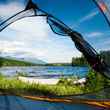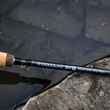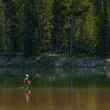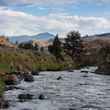If your goal is to catch a fish — a lot of fish — on a fly rod, the double-nymph rig should be your go-to setup.
No, it’s not terribly sexy — for many, spending a day staring at a strike indicator isn’t their idea of a great day on the water. Others have developed a real penchant for Euro-style high-stick nymphing that requires a bit more touch and some practice, but generally arrives at the same outcome: more fish. For some of us, the double-nymph rig is the outfit we choose when we just want to feel the tug, to know that the fish are there, even if they’re not rising to our size 22 Blue-winged Olive or chasing our meticulously tied streamer fished expertly on the swing.
No, I’m not shaming the nymphers. I’ll leave that to the growing chorus of fly fishers who, during a global pandemic that’s seen more and more people on the water, have righteously determined that catching more fish isn’t necessarily a good thing. And, when you couple their worries about the crowds on our rivers with the very existential threat of warming waters, low river flows and the resulting impacts on wild trout, they might have a point.
But let’s dispense with the ethics discussion—even the purists among us must recognize that trout feed below the surface about 90 percent of the time, and if we want to have consistent success, we’ll need to meet them at the buffet line, at least now and then. To that end, I’ve compiled a short list of killer double-nymph rigs. Yours might be different, but if I’m determined to catch fish on any given day, this is where I start.
A Girdle Bug and a Perdigon nymph
Consider this the double-Quarter-Pounder-served-with-fries approach. The Girdle Bug might be Picasso’s answer to a giant stonefly nymph — it’s impressionistic at best, with its gaudy rubber legs and oversized, chenille-wrapped body. It’s a big bite, even for big fish. When coupled with the fast-sinking size 18 or 20 Perdigon, the Euro-inspired, epoxy-coated, fast-sinking nymph that literally lives in the strike zone, this combo can be deadly.
The Euro crowd has gone “full Perdigon” of late, and this fly has proven its worth among the competition community. It’s very streamlined and, as it’s Spanish translation suggests (it means “pellet” for us uni-lingual losers), it sinks like a rock. But it’s not just for the high-stick crowd. Drifted under a robust indicator and behind the Girdle Bug, this fly helps keep both bugs in the sweet spot longer. If you’re an enthusiastic nympher and you haven’t tried a Perdigon yet … well, you’re probably still using Windows XP, too.
BUY GIRDLE BUG NYMPHS
BUY PERDIGON NYMPHS
A Prince Nymph and a Copper John
You’re sensing a trend here, right? Big point fly, small trailer. Better yet, a small, yet fast-sinking trailer. The logic is simple. A trailer fly with some weight pulls that point fly down into the water column a bit better, and that means both flies are in the feeding lane longer, regardless of whether you’re high-sticking or watching a bobber. And the Prince nymph might be the single-best attractor nymph ever tied — it’s heavy in its own right (a proper Prince is tied with lead or tungsten wire—preferably the latter), and the peacock herl body is a proven fish attractor. Tied with some white goose biot feathers and, in many cases, a shiny brass bead, it’s visible in darker water. When tied in sizes 10 or larger, it’s a serviceable stonefly imitation.
And the Copper John? Smaller, shinier and a fast sinker. It’s also a proven fish-getter, and it can be crafted at the vise using its traditional brass wire, or it can be tied with colored wire (think red, green or, my favorite, a bright chartreuse) to help grab the attention of fish feeding deep.
BUY PRINCE NYMPHS
BUY COPPER JOHN NYMPHS
Pheasant-tail Nymph and a Zebra midge
Big and little again? Why not? But, honestly, there’s no reason to go too big with the venerable Pheasant-tail nymph. It might be ideal “nymph for all seasons” — I’d wager that 90 percent of the nymph boxes out there have at least a half-dozen PTNs in them in sizes as big as 10 to as small as 18. For a double-nymph rig, it’s heavy enough, especially when tied in its bead-head version, to get down deep.
When trailed by the tiny Zebra—a midge nymph imitation usually tied in ridiculously small sizes (think 20 or even 22)—the Pheasant-tail serves as the attractor while the Zebra is likely going to match (or match close enough) one of the most prolific subsurface food sources available in any given river.
This set-up is ideal for cold-weather fishing when midges are the only bugs popping.
BUY PHEASANT TAIL NYMPHS
BUY ZEBRA MIDGE NYMPHS
A Bead-head Hare’s Ear and a Frenchie
We all know about the Bead-head Hare’s Ear—it’s likely as common as any nymph pattern tied anywhere. It’s usually tied with a bit of wire for the ribbing, which gives it a touch of flash. Also, its flashback thorax helps the fly look a bit more realistic than some of the other patterns we might normally consider for a double-nymph rig. The bead head helps it get down, albeit a bit slower thanks to the buggy hare’s ear dubbing. But that same dubbing gives the fly some subsurface action, which I think trout really dig.
But what’s the Frenchie? This is a fly that’s somewhat new to me, but it’s growing on me. Think of it as a Perdigon without the epoxy bath — it’s small, tight and sparse, which means it’s going to sink fast (and it’s ideal companion to the slower-sinking BHE thanks to the latter’s denser, dubbed construction) and find the strike zone quicker. I love Frenchies tied with a “hot spot,” or an ultraviolet-sensitive “tag” right behind the head of the fly. The Frenchie is a favorite among competition anglers and it’s a very poorly kept secret on Utah’s Green River. If you haven’t tied it or tried it, now’s the time.
BUY BHE NYMPHS
BUY FRENCHIE NYMPHS
The Rubber-Legs Stonefly and the San Juan Worm
By now, the purists have tossed their arms up in frustration. But bear with me. This is the ideal setup for high water fishing, either after a rainstorm or on the shoulders of spring runoff (I like this outfit for use during flushing flows on tailwater rivers). This is when the food sources these two behemoth subsurface flies imitate are going to be prevalent in the water.
First, stonefly nymphs cannot swim, so when they are “flushed” into the water column, they grab the attention of feeding trout. The Rubber-Legs Stonefly is really just a more realistic Girdle Bug, and it’s a big bite. Trailing it with a San Juan Worm, also representative of food that finds its way into the river during high water, is kind of like offering up that double Quarter-Pounder and chasing it with a Big Mac.
One note: this is the rig you probably don’t want to tie on in front of your fishing buddies. It’s sure to entice ridicule (but you’ll have the last laugh when you compare notes at the end of the day).
BUY RUBBER-LEG STONEFLY NYMPHS
BUY SAN JUAN WORM FLIES
Wrapping Up
Of course, the above suggestions are just that — I do think there’s merit in pairing larger nymphs with smaller trailers, but that’s purely based on my own anecdotal experiences. But if your ultimate goal is numbers (and, honestly, that’s not my ultimate goal that often these days), a double-nymph rig gives you the best chance to meet it.
But I’ll offer this up. I’m listening more and more to anglers who are less inclined to count fish and more inspired by the fish that might be harder to catch. You know… the big brown that’s feeding on top but will require that one perfect cast to reach. Or the rainbow that lives under the log in a deep run that got to be 22 inches long by not grabbing every Perdigon that drifts by.
By all means. Catch your fish. But please realize that the more you catch, the more you kill (even the best catch-and-release angler is going to lose some of their catch to mortality). Here’s my final admission: I’ve taken to using the double-nymph rig when I intend to harvest trout for the grill or the smoker. To me, if I’m out for numbers, I’m likely going to kill fish whether I intend to or not. On rivers where catching my limit (or even by limiting my catch) isn’t going to have a big impact on the population, I’m a shameless fish-killer. And the double-nymph rig is, whether we want to admit or not, a fish-killer.






























Comments
Paul Mesojednik replied on Permalink
Double rigs are simply productive. I strongly support using what I call a "split yoke" set up rather than tying on to the bend of the hook, when fishing two nymphs, regardless of size. I simply add a longer piece of FC tippet to my leader, and then tie in a second "tag" about 12-16" above the end of the bottom of the tippet, attempting to leave myself 8" of tippet to tie on my "upper fly". I use a triple surgeons knot for both added sections. I find I change flies more often, can add tippet to either section ( easier on the lower tag) and have fewer tangles and lost flies. Most tangles happen when in transit, so I've adopted the use of a 3" "gear tie -tm" re-usable rubber twist tie just above my cork and below my lower guide to hook my upper tag fly into when moving on the river. Always pinch your barbs please.
Mike Lundrigan replied on Permalink
Where I live we have hundreds of thousands, perhaps million of rivers, ponds and lakes and a small population of people! Many bodies of water have never seen a fisherman, ever! Here keeping some for the pan or smoker is the norm!
It is doubtful there is much impact on our trout populations except in the most popular fishing locations! I keep only a few and release the rest using a haemostat to gently remove the fly, never lifting the fish from the water! Touching it with your hand can remove the slime and the trout may die later from infection so I won’t do it if I do not intend to keep it! Been doing this for over thirty years!
Josh replied on Permalink
My winter go-to on the South Platte in Colorado is the last combo with a size 20 chocolate foam back emerger behind the worm. All 3 flies catch fish, with the foam back emerger doing most of the work. Weighted rubber legs in black or purple, tan or red SJ worm with gold bead. Rig covers different levels in the water column and the weighted rubber legs gets the rig down, reducing the need for split shot.
Pages